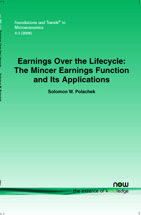Earnings Over the Life Cycle: The Mincer Earnings Function and Its Applications
By Solomon W. Polachek, Department of Economics, State University of New York, USA, polachek@binghamton.edu
Abstract
In 1958, Jacob Mincer pioneered an important approach to understand how earnings are distributed across the population. In the years since Mincer's seminal work, he as well as his students and colleagues extended the original human capital model, reaching important conclusions about a whole array of observations pertaining to human well-being. This line of research explained why education enhances earnings; why earnings rise at a diminishing rate throughout one's life; why earnings growth is smaller for those anticipating intermittent labor force participation; why males earn more than females; why whites earn more than blacks; why occupational distributions differ by gender; why geographic and job mobility predominate among the young; and why numerous other labor market phenomena occur. This review surveys the answers to these and other questions based on research emanating from Mincer's original earnings function specification.
Earnings Over the Life Cycle
While there have been a number of surveys on the Mincer earnings function, they focus heavily on econometric issues. While covering a number of econometric issues, Earnings over the Lifecycle: The Mincer Earnings Function and Its Applications focuses on the underlying economics behind the Mincer earnings function and its robustness and relevance to policy applications. Topics include verifying the consistently observed cross-sectional concavity and corroborating implications regarding earnings distribution particularly at the "overtaking" level of experience, across many countries and demographic groups. Among the policy relevant applications are how to use Mincer's theories to estimate discrimination, particularly race and gender differences in both earnings and occupational distributions. In addition, this book shows how the earnings function can be adapted to measure incomplete information in labor markets, an extension which is important in measuring the competitiveness of particular labor markets. The final part of Earnings over the Lifecycle: The Mincer Earnings Function and Its Applications explores incentive based compensation schemes. Some argue that such contract models complement human capital in explaining wages and other labor market phenomena; others argue that contract models substitute for the human capital model. The book concludes that one has to consider both types of models simultaneously in a unified framework to determine the relative merits of each.
